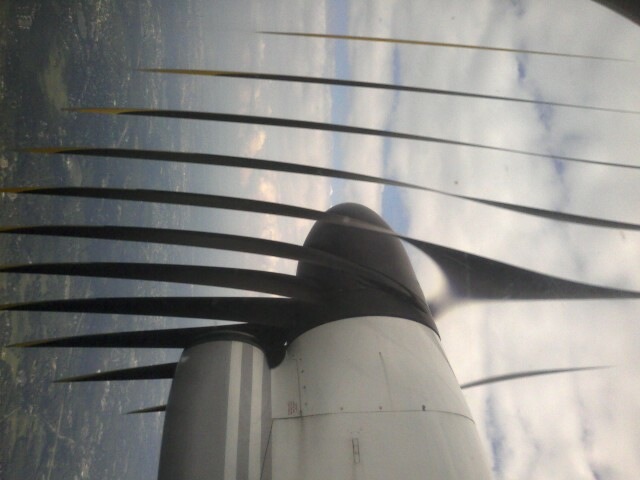the propellers go around (part 2)
… but not on camera.
This is part of the Toronto visit series.
So I inadvertently took a picture of the running propeller on my side of the plane, and it came out weird. And I mean, really weird (1):

The propeller does not look like this. It has like six blades spaced out evenly and all of them straight. So of course this is due to aliasing of the damned camera. But wait now, I just said not too long ago that this is photography, so indeed, I only took this and
this (2)

and this (3)

along with this (4)

because I was strangely mesmerized. Not only is this pseudo-reality only observable through a cheap phone camera like this, but I’m measuring the camera as much as I’m measuring the propeller.
See, the effect is only possible because the phone camera has no shutter (so DSLR’s shouldn’t exhibit this). The image is literally read out line by line, top to bottom. By the looks of it, all pixels on one horizontal scanline are read out or replicated to memory in parallel, but different scanlines belong to different times, with a sampling time gap between lines. Meanwhile, the propeller moved on. Since the angle between attachment points of the blades is reduced in (1) and expanded in (4), the propeller is spinning clockwise.
However, what appears to be the blades in these photos, are not the blades! Otherwise how could some of them hang around in mid-air and also have two ends. Well, first note that the entire region where there are fin-like objects is circumscribed by the elliptical region that the real propeller traces out (from this viewpoint). This clue suggests that each discrete piece is a portion of an image of a single blade sweeping through a certain angular range. It’s only a portion, because the blade in question is captured only when it is within the current scanning region. Once it’s out, the camera doesn’t “see” it. There are gaps between these discrete pieces because there is an angular gap between two adjacent blades on the propeller.
If the rotational speed of the propeller is known then we can even figure out the rate at which image lines are scanned. As is, there are about a dozen or so discrete pieces in a single image, so given that there are only six blades, the propeller makes nearly two turns during the shot.
 Comments(2)
Comments(2)
[...] If it looks like our panorama hacks, there's a reason. A slit-scan camera is basically a low-tech panorama that's more prone to artful glitches. Many digital cameras use some version of the same process, which is how you end up with pictures like this one. [...]
[...] If it looks like our panorama hacks, there's a reason. A slit-scan camera is basically a low-tech panorama that's more prone to artful glitches. Many digital cameras use some version of the same process, which is how you end up with pictures like this one. [...]